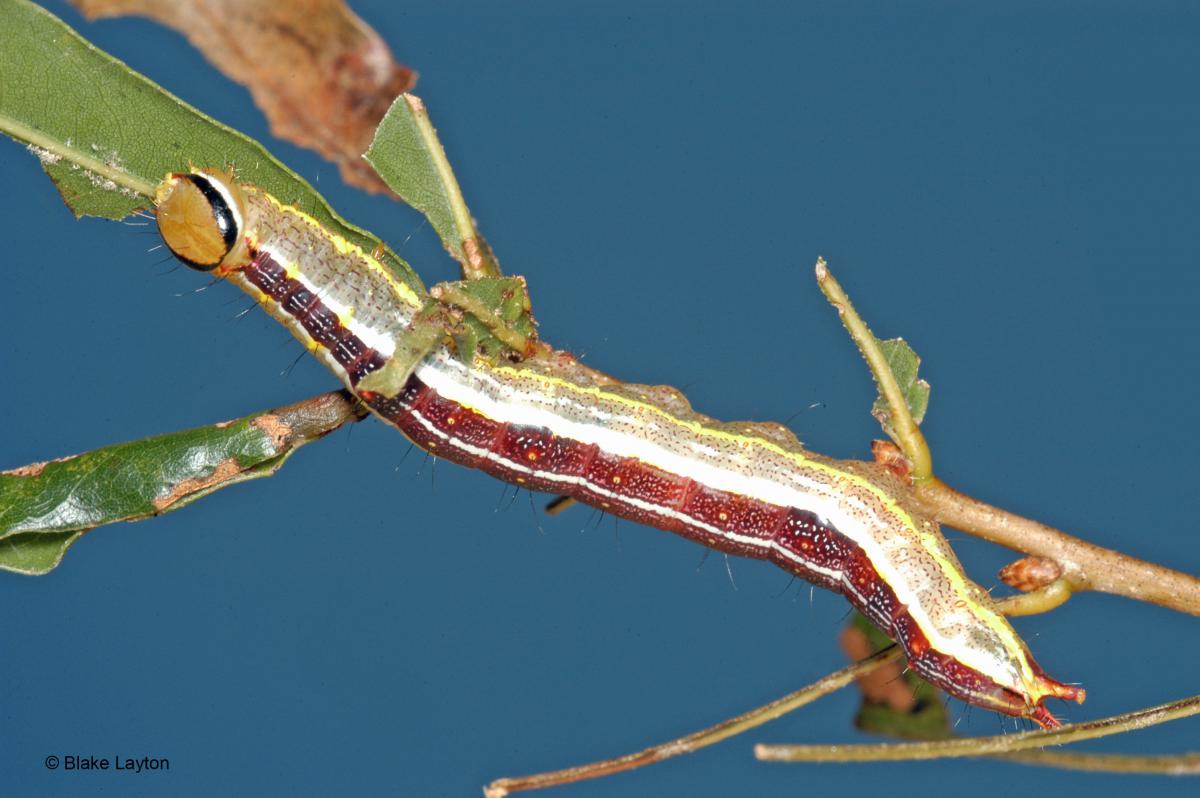Variable Oakleaf Caterpillar | Vol. 3, No. 19
Filed Under:
July 12, 2017

Lochmaeus manteo
Order: Lepidoptera
Family: Notodontidae
Variable oakleaf caterpillars are common on oaks and other hardwoods throughout the state, but especially in the northern part of the state. Normally, their populations are kept in check by a variety of beneficial insects and diseases, including tiny wasps that parasitize their eggs. But during outbreak years these caterpillars can cause severe, and even complete, defoliation of oaks and other hardwoods. This is such a year, at least in the northern part of the state, where some trees have already been defoliated by first generation caterpillars. These caterpillars have two generations per year in the South, and second generation caterpillars may cause additional defoliation of trees in other locations. As the name suggests, variable oakleaf caterpillars vary considerably in color, but the dark “sideburns” on either side of the head capsule are good identification clues as few other caterpillars have these. One exception is the double-lined prominent, which looks similar and belongs to the same genus. Mature caterpillars are about 1.5 inches long.
Control: It is usually impractical to attempt to control defoliating caterpillars on large landscape trees because: 1} trees are too big to spray, 2} risk of off-target spray drift is too great, and/or 3} most of the damage has already been done by the time the infestation is noticed and the infestation has almost run its course. Fortunately, healthy hardwood trees usually recover, even from being completely defoliated, without suffering serious long-term injury. Keeping trees watered during periods of drought will aid recovery. Insecticides containing spinosad (Fertilome, Green Light, Bonide, Monterey, and others sell homeowner formulations, and Conserve is for commercial applicators.) or chlorantraniliprole (Acelepryn, for commercial applicators) can be used to control caterpillars on small or high value trees in cases where such applications are practical.
Variable oakleaf caterpillars are common on oaks and other hardwoods throughout the state, but especially in the northern part of the state. Normally, their populations are kept in check by a variety of beneficial insects and diseases, including tiny wasps that parasitize their eggs. But during outbreak years these caterpillars can cause severe, and even complete, defoliation of oaks and other hardwoods. This is such a year, at least in the northern part of the state, where some trees have already been defoliated by first generation caterpillars. These caterpillars have two generations per year in the South, and second generation caterpillars may cause additional defoliation of trees in other locations. As the name suggests, variable oakleaf caterpillars vary considerably in color, but the dark “sideburns” on either side of the head capsule are good identification clues as few other caterpillars have these. One exception is the double-lined prominent, which looks similar and belongs to the same genus. Mature caterpillars are about 1.5 inches long.
Control: It is usually impractical to attempt to control defoliating caterpillars on large landscape trees because: 1} trees are too big to spray, 2} risk of off-target spray drift is too great, and/or 3} most of the damage has already been done by the time the infestation is noticed and the infestation has almost run its course. Fortunately, healthy hardwood trees usually recover, even from being completely defoliated, without suffering serious long-term injury. Keeping trees watered during periods of drought will aid recovery. Insecticides containing spinosad (Fertilome, Green Light, Bonide, Monterey, and others sell homeowner formulations, and Conserve is for commercial applicators.) or chlorantraniliprole (Acelepryn, for commercial applicators) can be used to control caterpillars on small or high value trees in cases where such applications are practical.
Blake Layton, Extension Entomology Specialist, Mississippi State University Extension Service.
The information given here is for educational purposes only. Always read and follow current label directions. Specific commercial products are mentioned as examples only and reference to specific products or trade names is made with the understanding that no discrimination is intended to other products that may also be suitable and appropriately labeled.
Sign up to receive Bug's Eye View.

